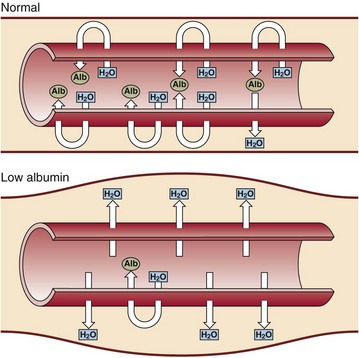25 Albumin is the major plasma protein and is synthesized and secreted by the liver. It has a biological half-life in plasma of about 20 days and it accounts for about 50% of the total hepatic protein production. Albumin makes the biggest contribution to the plasma oncotic pressure. If the albumin concentration falls very low, oedema is the result (Fig 25.1). There are four main reasons for the occurrence of a low plasma albumin concentration: Measurement of a number of specific proteins gives useful information in the diagnosis and management of disease (Table 25.1). Characteristic changes in the concentration of certain plasma proteins are seen following surgery or trauma, or during infection or tumour growth. The proteins involved are called acute phase reactants (pp. 110–111). These acute phase proteins may be used to monitor progress of the condition or its treatment. Table 25.1 Specific proteins that are measured in serum
Proteins and enzymes
Plasma proteins
Albumin
 Abnormal distribution. Albumin can move into the interstitial space as a result of increased capillary permeability in the acute phase response.
Abnormal distribution. Albumin can move into the interstitial space as a result of increased capillary permeability in the acute phase response.
 Decreased synthesis. Due to malnutrition, malabsorption or advanced chronic liver disease.
Decreased synthesis. Due to malnutrition, malabsorption or advanced chronic liver disease.
 Dilution. Hypoalbuminaemia can be induced by overhydration.
Dilution. Hypoalbuminaemia can be induced by overhydration.
 Abnormal excretion or degradation. The causes include the nephrotic syndrome, protein-losing enteropathies, burns, haemorrhage and catabolic states.
Abnormal excretion or degradation. The causes include the nephrotic syndrome, protein-losing enteropathies, burns, haemorrhage and catabolic states.
Specific proteins
Protein name
Function
Reason for assay
α1-antitrypsin
Protease inhibitor
Reduced in α1-antitrypsin deficiency
β2-microglobulin
A subunit of the HLA antigen
![]()
Stay updated, free articles. Join our Telegram channel

Full access? Get Clinical Tree

 Get Clinical Tree app for offline access
Get Clinical Tree app for offline access

